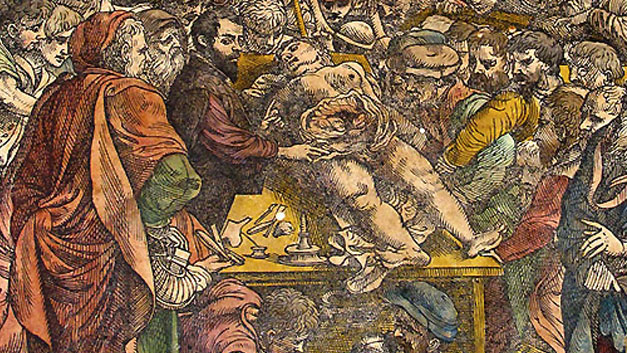EVANSTON, Ill. --- Andreas Vesalius’ “De Humani Corporis Fabrica” -- a treasure of Renaissance bookmaking and the most significant work in the development of medicine and anatomy -- has just been published in English.
With a price tag of $1,650 and 5,000-plus footnotes, the translation by two Northwestern University emeriti professors comes in a Plexiglas case and weighs in at 35-plus pounds.
“I wouldn’t wait for the paperback,” jokes Dan Garrison, the classics professor emeritus who translated and worked on the doorstop of a book with Malcolm Hast, emeritus professor of otolaryngology at the Feinberg School of Medicine.
“On the Fabric of the Human Body” contained more than 250 intricate woodcut drawings of human anatomy when it was first published. Probably created in the studio of the great Renaissance artist Titian, many are familiar still to students of medicine and art around the world.
The emeriti professors and president of Karger AG, the Swiss publisher that produced the translation, present the book today to an audience of medical students and professionals, collectors and historians at Galter Health Sciences Library. In 2014, Garrison and Hast will make similar presentations in Europe at events marking the 500th anniversary of Vesalius’ birth.
“The Fabrica came out in 1543, the same year that Copernicus revolutionized our understanding of the cosmos with the publication of ‘Revolutions of the Heavenly Bodies,’” says Garrison. “While not quite the same paradigm shifter, Vesalius’ work revolutionized the study and teaching of human anatomy by focusing on human dissection, observation and skepticism.”
Obsessed with hands-on research, Vesalius was known to rob graveyards to collect human specimens for his dissections. By championing observation and dissection, Vesalius challenged the Greek Galen’s conception of the human body -- based on the study of farm animals and Barbary apes – that had been accepted for 14 centuries.
At a time when Christians and Jews were still uncomfortable about the use of human cadavers, Vesalius performed dramatic human dissections before audiences of physicians, art students and medical students in large theatres in Pisa, Padua and Bologna.
Hast, a professor specializing in the anatomy and physiology of the larynx, approached Garrison, an interpreter of Latin poetry, to help him translate a small portion of the Fabrica focused on the larynx. Over more than 20 years, the project extended to translating and annotating the entire 1543 Fabrica and a second 1555 edition.
Karger Publishers “turned the 16th century work into a user-friendly 21st century book by employing all the techniques that are used in textbook publishing today,” says Hast. They even asked a Swiss font designer to develop a new font to create a modern rendition of the 16th century typeface.
The work’s 273 illustrations have been “cleaned up,” says Hast, “making them even more beautiful than they originally appeared.”
Garrison says he and Hast have been extraordinarily lucky throughout the project, garnering support from the Mellon Foundation, the National Institutes of Health and the National Endowment for the Humanities. But it was a surprise $1 million donation from the Kuwaiti Minister of Health that allowed their translation “to be the best that it could be.”
A copy of the translation will be available at Northwestern’s Galter Health Sciences Library. Visit Vesalius Fabrica to learn more about this user-friendly translation.

